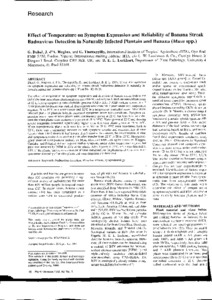| dc.contributor.author | Dahal, G. |
| dc.contributor.author | Hughes, J. |
| dc.contributor.author | Thottappilly, G. |
| dc.contributor.author | Lockhart, B.E.L. |
| dc.date.accessioned | 2019-12-04T11:22:25Z |
| dc.date.available | 2019-12-04T11:22:25Z |
| dc.date.issued | 1998 |
| dc.identifier.citation | Dahal, G., Hughes, J., Thottappilly, G. & Lockhart, B. (1998). Effect of temperature on symptom expression and reliability of banana streak badnavirus detection in naturally infected plantain and banana (Musa spp.). Plant Disease, 82(1), 16-21. |
| dc.identifier.issn | 0191-2917 |
| dc.identifier.uri | https://hdl.handle.net/20.500.12478/4004 |
| dc.description.abstract | The effect of temperature on symptom expression and detection of banana streak badnavirus (BSV) by immunosorbent electronmicroscopy (ISEM) and enzyme-linked immunosorbent assay of 12 in vitro-propagated plantain hybrids (genome AAB × AA), 3 ABB cooking banana, and 3 AAB plantain landraces was studied. Experiments were done for 2 years under two temperature regimes, 28 to 35°C in a screenhouse and 22°C in a temperature-controlled room. Most BSV-infected plants of plantain hybrids expressed symptoms under both conditions. Symptom expression was enhanced when plants were continuously grown at 22°C, but later became indiscernible when plants were continuously grown at 28 to 35°C. Plants grown at 22°C and showing severe symptoms contained significantly higher virus titer than plants grown at 28 to 35°C. When asymptomatic plants with very low virus titer at 28 to 35°C were transferred back to 22°C, there was a significant increase in both symptom severity and concentration of virus (greater than 3 to 5 times) in leaf tissues after 9 months. In contrast, the concentration of virus and symptom severity decreased in plants after transfer from 22°C to 28 to 35°C. Micropropagated plants of AAB plantain landrace cv. Mimi Abue and ABB cooking bananas (cvs. Bluggoe, Cardaba, and Pelipita) did not express visible symptoms under either temperature regime, but BSV was detected by ISEM in 23% of the plants. After 2 years at 22°C, virus was detected in 64% of the plants, but the concentration of virus remained low. Implications of these results on quarantine screening of in vitro plants and virus diagnosis are discussed. |
| dc.language.iso | en |
| dc.subject | Badnavirus Detection |
| dc.subject | Musa Badnavirus |
| dc.subject | Symptomatology |
| dc.title | Effect of temperature on symptom expression and reliability of banana streak badnavirus detection in naturally infected plantain and banana (Musa spp.) |
| dc.type | Journal Article |
| dc.description.version | Peer Review |
| cg.contributor.affiliation | International Institute of Tropical Agriculture |
| cg.contributor.affiliation | University of Minnesota |
| cg.coverage.region | Africa |
| cg.coverage.region | West Africa |
| cg.coverage.country | Nigeria |
| cg.isijournal | ISI Journal |
| cg.authorship.types | CGIAR and advanced research institute |
| cg.iitasubject | Plant Diseases |
| cg.iitasubject | Pests Of Plants |
| cg.iitasubject | Disease Control |
| cg.iitasubject | Climate Change |
| cg.iitasubject | Plantain |
| cg.accessibilitystatus | Limited Access |
| local.dspaceid | 99290 |
| cg.identifier.doi | https://doi.org/10.1094/PDIS.1998.82.1.16 |

